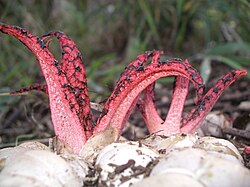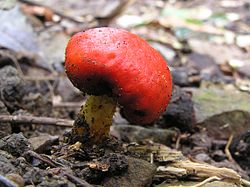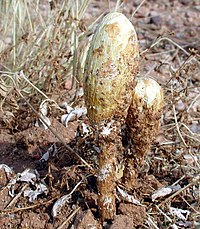Gasteroid fungi
(literally "stomach fungi"), or the equally obsolete order Gasteromycetales Rea, because they produce spores inside their basidiocarps (fruit bodies) rather than on an outer surface.Several gasteroid fungi—such as the stinkhorn, Phallus impudicus L.—were formally described by Carl Linnaeus in his original Species Plantarum of 1753, but the first critical treatment of the group was by Christiaan Hendrik Persoon in his Synopsis methodica fungorum of 1801.[4] This convenient division continued to be used for the next 150 years or so, although by the middle of the twentieth century it had become evident that Gasteromycetes was an artificial class (bringing together a miscellany of unrelated species) and not a natural one.The same ingenious mechanism has evolved separately in the earthstars (Geastrum species), which have a hard outer layer to the fruitbody that splits open in a star-like manner to reveal the puffball-like spore sack.[11] The bird's nest fungi, which include the genera Cyathus and Crucibulum, form miniature, egg-like packets of spores within cup-shaped fruit bodies.



Lycoperdon perlatumBasidiomycotasporesbasidiocarpspolyphyleticpuffballsearthballsearthstarsstinkhornsbird's nest fungifalse trufflestaxonomicClathrus archeriPhallus impudicusCarl LinnaeusSpecies PlantarumChristiaan Hendrik PersoonInternational Code of Nomenclature for algae, fungi, and plantssanctionedElias Magnus FriesAscomycotatrufflesAgaricomycetesLeratiomyces erythrocephalusagaricsLycoperdonBovistaCalvatiaostioleGeastrumPhallusMutinusClathrusLysurusCyathusCrucibulumRhizopogonHymenogasterMelanogastersecotioidLeratiomycesPodaxis pistillarissaprotrophicSclerodermaPisolithusectomycorrhizalcosmopolitanPodaxisBattarreaPhelloriniaTulostomasteppestemperateWayback MachineBibcode